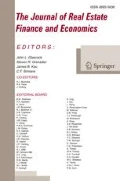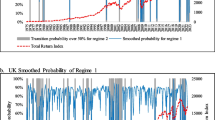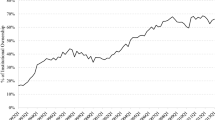Abstract
Employing dividend yield decomposition, this paper explores the inflation illusion and inflation hedging effects on REIT stock prices. Results show that changes in expected inflation explain a large share of the time series variation of the mispricing component of the dividend yield. Also, while both inflation hedging and inflation illusion effects exist for REITs, the inflation illusion effect tends to dominate the hedging effect during the 1980 to 2008 period. These results suggest that investors are unable to quickly reconcile changes in discount rates and dividend growth rates associated with inflation into stock prices. The findings also provide an alternative explanation as to why short-term REIT returns are often negatively related to expected inflation.




Similar content being viewed by others
Notes
Although some researchers find evidence supporting the hypothesis, suggesting that inflation illusion has a significant impact on stock prices, others including Thomas and Zhang (2007) argue that the debate remains open.
Piazzesi and Schneider (2008) and Brunnermeier and Julliard (2008) examine the inflation illusion effect in owner-occupied housing and find home purchasers are prone to inflation illusion. Finding an inflation illusion effect does not mean that real estate is not an inflation hedge over the long term. The illusion effect addresses short-term continuous recalibration of the impact of inflation on asset prices.
Private non-exchange traded REITs are also possible, but are not the focus of this study.
See Hartzell et al. (1987), Sirmans and Sirmans (1987) and Gyourko and Linneman (1988). A few studies show that REITs are long-term inflation hedges (Chatrath and Liang (1998) and Hoesli et al. (2008)) and that REITs are partial inflation hedges when a survey measure of inflation is used (Park et al. (1990)).
There is mixed evidence on this issue. For example, Ling and Naranjo (1999) show that the REIT market is more integrated with the general stock market and the degree of integration was significantly increased during the 1990s. Other studies (e.g., Chiang et al. (2005)) suggest that there is no strong evidence indicating the market betas of REITs have changed during the period of 1972–2002. For more discussion on this issue, see the background section below.
A related initial analysis based on US inflation data and the REIT premium to Net-Asset-Value (NAV) data from Green Street Advisors, Inc., suggests that when US inflation is relatively high, REIT stocks typically sell at a discount over their NAVs.
For example, Below et al. (2000) show that since 1992 REIT institutional ownership increased dramatically.
Some analysts have argued that the high dividend payouts for REITs should give REITs some bond like return features even though they are stocks. This should reduce price volatility meaning that REITs should be less susceptible to inflation illusion and have some hedging characteristics. This is tested in this study.
Campbell and Vuolteenaho (2004) point out that the conventional interpretation of the Fed model implicitly compares apples to oranges, as in real term neither the long-term discount rate nor the dividend growth rate will change. Thus, a change in long-term expected inflation will leave the dividend price ratio unchanged.
Changes in what is typically called the “Five or Fewer rule” in 1992 allowed institutional investors to substantially increase their exposure to REITs.
The creation of the UPREIT structure in 1992 provided tax benefits for transferring property from existing real estate partnerships to REITs, which stimulated the growth of the REIT industry during the modern REIT era.
The argument is somewhat nuanced. As REITs become part of the market measure, the asset class returns are more likely to be linked.
According to the Fed model, the long-term discount rate (R) typically consists of two parts, the yield of bonds and a proxy for the risk premium of stocks over bonds.
We recognize that there are some issues to use a single factor CAPM model in the REIT context. However, for our purpose, the CAPM model is mainly used for constructing a proxy of cross-sectional equity risk premium (λt) for all stocks including REITs.
We focus on two REIT indices: total REIT index and equity REIT index. Since mortgage REITs only invest in mortgage products and their daily operation consists of lending, buying and selling mortgage backed securities, and loan servicing, we do not include mortgage REIT index in our study. Equity REITs are operating real estate companies, mainly engaged in the acquisition, management, development and sale of real estate assets. The total REIT index is based on return data from both equity and mortgage REITs.
With statistically insignificant coefficients on the dividend yield, the evidence based on the equal-weighted index is weaker.
The results are not reported here.
In 1992, the “Umbrella Partnership REIT” (“UPREIT”) operating structure was developed. This is often credited as one of catalysts for the growth in the modern REIT industry. There were also changes in the “five or fewer” rule and other regulatory constraints.
There are several factors that could potentially weaken the inflation illusion and/or hedging effects during 1993–2008, when data from the financial crisis period are included. First, the market value of REITs drops substantially starting from 2007 to the last quarter 2008 as the financial markets become more distressed. Second, the credit markets froze during the latter part of 2008 for all firms and investors faced tremendous uncertainty about the future of the stock market. Third, inflation rates were close to zero around the end of 2008. Given this generational breakdown in fundamental market relations, one might expect that the inflation illusion and hedging effects on REIT are less evident for this latter period (1993–2008) which includes the financial crisis. Nevertheless, our results based on the full sample period still hold well.
One additional robustness check for the main empirical results is conducted based on Chen and Zhao (2009). Chen and Zhao point out that a decomposition approach that directly estimates the discount rate news but only adjusts the cash flow news has potential limitations. One method they propose is to directly model both the discount rate and the cash flow components with a VAR model. We use the present value of expected future dividend growth as a measure of expected cash flows and re-estimate the empirical models. The results are qualitatively similar to the main results.
References
Ambrose, B. W., Lee, D. W., & Peek, J. (2007). Comovement after joining an index: spillovers of nonfundamental effects. Real Estate Economics, 35(1), 57–90.
Amihud, Y. (1996). Unexpected inflation and stock returns revisited—evidence from Israel. Journal of Money, Credit and Banking, 28(1), 22–33.
Asness, C. S. (2003). Fight the Fed model: the relationship between future returns and stock and bond market yields. Journal of Portfolio Management, 30(1), 11–24.
Below, S. D., Stansell, S. R., & Coffin, M. (2000). The determinants of REIT institutional ownership: tests of the CAPM. Journal of Real Estate Finance and Economics, 21(3), 263–278.
Bodie, Z. (1976). Common stocks as a hedge against inflation. Journal of Finance, 31(2), 459–470.
Brunnermeier, M. K., & Julliard, C. (2008). Money illusion and housing frenzies. Review of Financial Studies, 21(1), 135–180.
Campbell, J. Y. (1991). A variance decomposition for stock returns. Economic Journal, 101, 157–179.
Campbell, J. Y., & Shiller, R. J. (1988). The dividend-price ratio and expectations of future dividends and discount factors. Review of Financial Studies, 1(3), 195–228.
Campbell, J. Y., & Vuolteenaho, T. (2004). Inflation illusion and stock prices. American Economic Review, 94(2), 19–23.
Chatrath, A., & Liang, Y. (1998). REITs and inflation: a long-run perspective. Journal of Real Estate Research, 16(3), 311–325.
Chen, L., & Zhao, I. X. (2009). Return decomposition. Review of Financial Studies, 22(12), 5213–5249.
Chiang, K. C. H., Lee, M., & Wisen, C. (2005). On the time-series properties of real estate investment trust betas. Real Estate Economics, 33(2), 381–396.
Cohen, R., Polk, C., & Vuolteenaho, T. (2005). Money illusion in the stock market: the Modigliani-Cohn hypothesis. Quarterly Journal of Economics, 120(2), 639–668.
Fama, E. F., & Schwert, G. W. (1977). Asset returns and inflation. Journal of Financial Economics, 5(2), 115–146.
Fama, E. F., & French, K. R. (2001). Disappearing dividends: changing firm characteristics or increased reluctance to pay? Journal of Financial Economics, 60(1), 3–43.
Fehr, E., & Tyran, J. R. (2001). Does money illusion matter? American Economic Review, 91(5), 1239–1262.
Geske, R., & Roll, R. (1983). The fiscal and monetary linkage between stock returns and inflation. Journal of Finance, 38(1), 1–33.
Glascock, J. L., Lu, C., & So, R. (2002). REIT returns and inflation: perverse or reverse causality effects? Journal of Real Estate Finance and Economics, 24(3), 301–317.
Gordon, M. (1962). The investment, financing, and valuation of the corporation. Homewood: Irwin.
Gultekin, N. B. (1983). Stock market returns and inflation: evidence from other countries. Journal of Finance, 38(1), 49–65.
Gyourko, J., & Linneman, P. (1988). Owner-occupied homes, income-producing real estate and REITs as inflation hedges. Journal of Real Estate Finance and Economics, 1(4), 347–372.
Hartzell, D., Hekman, J. S., & Miles, M. E. (1987). Real state returns and inflation. AREUEA Journal, 15(1), 617–637.
Hoesli, M., Lizieri, C., & MacGregor, B. (2008). The inflation hedging characteristics of US and UK investments: a multi-factor error correction approach. Journal of Real Estate Finance and Economics, 36(2), 183–206.
Kallberg, J. G., Liu, C. H., & Srinvasan, A. (2003). Dividend pricing models and REITs. Real Estate Economics, 31(3), 425–450.
Khoo, T., Hartzell, D., & Hoesli, M. (1993). An investigation of the change in real estate investment trust betas. Journal of the American Real Estate and Urban Economics Association, 21(2), 107–130.
Ling, D. C., & Naranjo, A. (1999). The integration of commercial real estate markets and stock markets. Real Estate Economics, 27(3), 483–515.
Modigliani, F., & Cohn, R. (1979). Inflation, rational valuation, and the market. Financial Analysts Journal, 37, 24–44.
Park, J. Y., Mullineaux, D. J., & Chew, I. K. (1990). Are REITs inflation hedges? Journal of Real Estate Finance and Economics, 3(1), 91–103.
Piazzesi, M., & Schneider, M. (2008). Inflation illusion, credit, and asset pricing. In J. Y. Campbell (Ed.), Asset prices and monetary policy (pp. 147–189). Chicago: The University of Chicago Press.
Polk, C., Thompson, S., & Vuolteenaho, T. (2006). Cross-sectional forecasts of the equity premium. Journal of Financial Economics, 81(1), 101–141.
Ritter, J. R., & Warr, R. (2002). The decline of inflation and the bull market of 1982–1999. Journal of Financial and Quantitative Analysis, 37(1), 29–61.
Sirmans, G. S., & Sirmans, C. F. (1987). The historical perspective of real estate returns. Journal of Portfolio Management, 13(3), 22–31.
Thomas, J., & Zhang, F. (2007). Inflation illusion and stock prices: Comment. Yale School of Management working paper.
Titman, S., & Warga, A. (1989). Stock returns as predictors of interest rates and inflation. Journal of Financial and Quantitative Analysis, 24(1), 47–58.
Vuolteenaho, T. (2002). What drives firm-level stock returns? Journal of Finance, 57(1), 233–264.
Williams, J. B. (1938). The theory of investment value. Cambridge: Harvard University Press.
Author information
Authors and Affiliations
Corresponding author
Appendix
Appendix
The Procedure to Estimate Cross-Sectional Risk Measure, “λ”
This appendix describes how we compute the cross-sectional price of risk in three steps by following Polk et al. (2006).
First, a number of valuation ratios for all stocks are computed to construct a robust composite measure of multiple different valuation measures for the period of 1926 to 2008. Because of likely structure breaks, instead of using an ordinal composite measure of the valuation multiple, the valuation ratios are transformed into a composite rank, with a higher rank denoting higher expected return (e.g., if rank = 99, then, the firm has higher expected return). Specifically, four raw ratios are calculated: dividend to price ratio (D/P), book to market equity ratio (BE/ME), earnings to price (E/P), cash flow to price (C/P). Data sources and method used are as follows:
-
1.
CRSP monthly stock file, providing monthly prices, shares outstanding, dividends and returns for NYSE, AMEX, and Nasdaq portfolios.
-
2.
Compustat Annual file: BE is stockholders’ equity, plus balance sheet deferred taxes (Compustat item 74, set to zero if unavailable) and investment tax credit (item 208, set to zero if unavailable), plus post-retirement benefit liabilities (data item 330, set to zero if unavailable), minus the book value of preferred stock.
-
3.
Stockholders’ equity—use the stockholder’s equity number reported Compustat (item 216).
-
4.
E is calculated as the three-year moving average of income before extraordinary items (item 18). C is measured as the three-year moving average of income before extraordinary items plus depreciation and amortization (item 14).
-
5.
Match D along with the BE, E, and C for all fiscal year ends in calendar year t-1 with the firm’s market equity at the end of May year t to compute D/P, BE/ME, E/P, and C/P. This is done by merging Compustat and CRSP data sets by CUSIP number.
-
6.
To transform these accounting ratios into a single annual ordinal composite measure of firm-level valuation, each year we independently transform each ratio into a percentile rank (using proc rank, and let group = 100), defined as the rank divided by the number of firms for which the data are available. After computing these four relative percentile rankings, we average the available accounting ratio percentile ranks for each firm.
-
7.
The ratios are averaged and re-ranked to get percentile for each firm. This average is then re-ranked across firms, resulting in expected return measure, VALRANKit.
Second, betas for individual stocks are computed. The monthly measure of risk is estimated market beta, βi,t . The contemporaneous return on the value-weight NYSE-Amex-Nasdaq portfolio is used to estimate the betas.
Third, the association between valuation rank and beta is computed based on the Spearman rank correlation technique. This correlation is used as the measure of the cross-sectional beta premium. The resulting monthly series for the proxies begins in May 1927 and ends in December 2008.
Rights and permissions
About this article
Cite this article
Hardin, W.G., Jiang, X. & Wu, Z. REIT Stock Prices with Inflation Hedging and Illusion. J Real Estate Finan Econ 45, 262–287 (2012). https://doi.org/10.1007/s11146-010-9259-y
Published:
Issue Date:
DOI: https://doi.org/10.1007/s11146-010-9259-y




